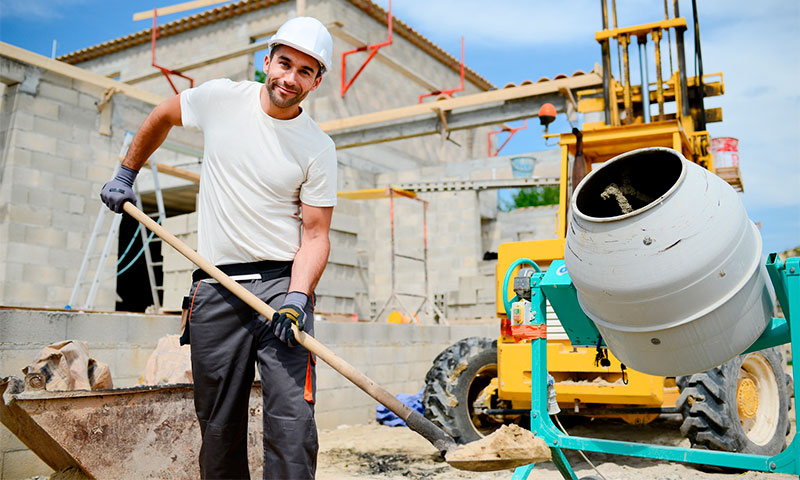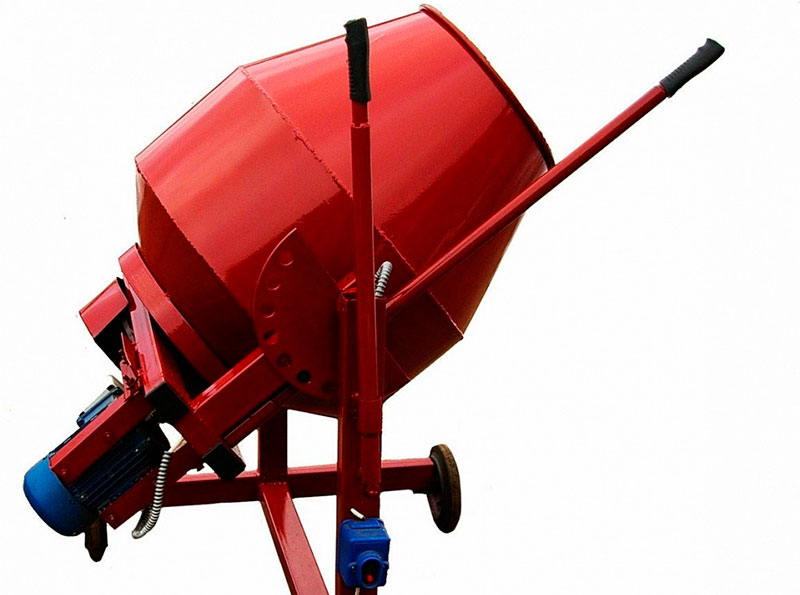Any construction site needs special equipment for the production of the mortar needed to fill the foundation or brickwork. Before pouring concrete into the garden paths or erecting a three-story cottage, you need to pick up a concrete mixer so as not to throw money at an unnecessarily powerful device. At the same time it is impossible to allow the lack of a solution to restrain work on the construction or landscaping of the territory. What equipment will satisfy all these requirements? Make the right choice will help article.

Content:
The best manufacturers of concrete mixers - which company to choose
It is necessary to treat the acquisition of a concrete mixer responsibly, because the reliability of the erected structure depends on the quality of the prepared mixture.
The best manufacturers of concrete mixers include the following:
- Lebedyan;
- Denzel;
- Inforce;
- ZITREK;
- Profmash.
Assistance in choosing a specific model that meets the requested requirements will provide rating of the best concrete mixers.
The principle of operation and the device concrete mixer

Regardless of the type of concrete mixer in its design includes the main elements:
1. Drum - a cylindrical, biconical, barrel-shaped or pear-shaped container in which a concrete solution or other mortar is prepared;
2. Blades - metal plates that mix the solution, prevent the working mixture from sticking to the drum walls;
3. Frame - welded steel structure on which the loading capacity and control unit are installed;
4. Electric motor - through the drive mechanism drives the elements of the mechanism (drum or blade);
5. The control unit - serves to enable and disable the device, adjust the speed of rotation.
The principle of operation depends on the type of concrete mixer, which can be gravitational and forced action.
In the equipment of forced action, the drum remains stationary during the production of the solution - the mixture is formed due to the rotation of the blades or auger located inside the tank. To unload the finished solution, open the slide valve located in the bottom of the drum.
In a gravitational device, the mixture is prepared with a rotating container. The blades located inside the tank remain stationary.
Mixing solution rises due to the rotation of the drum, then falls under the action of gravity. At the same time, the fixed blades divide the cement-concrete base, improving the process of solution preparation and forming a more homogeneous mass.
Unload the finished building material by changing the angle of inclination of the tank with a lever or control wheel.
For the convenience of moving around the construction site, most of the cement mixers are equipped with wheels mounted on the frame.
Types of concrete mixers
Forced action concrete mixers

The main areas of application of the equipment:
1. Production of inactive and rigid concrete mixes;
2. Production of solutions on dense and porous fillers;
3. Production of mixes for blocks, curbstone, paving slabs and bricks made by semi-dry vibropressing and vibratory casting.
Benefits:
- Mixing to high uniformity in a short period of time;
- Efficiency when working with both liquid and immobile mixtures;
- Long service life.
Disadvantages:
- High energy consumption;
- The composition of the prepared mixtures should include components of approximately the same density.
Gravity Concrete Mixers

Benefits:
- Unpretentiousness in work;
- Universality of the mixed substances;
- Democratic value;
- Reliability and ease of construction.
Disadvantages:
- Long time mixing substances to obtain a homogeneous mixture.
Gearbox mixers

Gear mixers can be used to produce a wide range of mixtures with different size fractions. Most often the equipment is used in professional activities, but it can be used in individual construction.
Benefits:
- Rare failure due to the impossibility of contamination of the gearbox in the process, due to its location (under the bottom of the drum);
- Low noise.
Disadvantages:
- In the event of a device failure due to a gearbox failure, its recovery is difficult and expensive.
- Require more careful operation in comparison with the coronary equipment.
Coronal Concrete Mixers

Concrete mixers of this type are most popular in private construction, as well as in small companies that carry out repair and construction work.
The circumference of the drum girdles the crown - toothed gear with a large internal diameter, which is in the process of preparing the solution is subjected to heavy loads and dirt, which can cause equipment failure.
The material of which the crown is made is important, which affects the maintainability and the life of the device as a whole.
Varieties of crowns, their features, advantages and disadvantages:
1. Polyamide - a polymer that can withstand considerable mechanical stress, is not exposed to the harmful effects of the environment. During operation, the noise level is negligible. Economical when repairing: the polyamide crown is made, as a rule, of four elements, which simplifies its restoration - it is enough to replace the damaged part;
2. Cast iron - most models are equipped with a cast-iron crown. In case of violation of operating conditions (strong vibration caused by incorrect installation of the concrete mixer; accidental falling or striking with an improvised tool), the crown cracks and fails. The gear element cannot be repaired, but it can be replaced with a new one.
3. Steel - this version is the most expensive, due to the specifics of the production of a gear element. A steel crown is reliable and durable, but an overly laborious manufacturing process limits the production of equipment with a steel crown.
Benefits:
- Low price and fast payback with intensive use;
- Economy - consume a small amount of electricity;
- Suitable for the formation of mixtures containing krupnofraktsionnyh components;
- Convenience of unloading the finished solution and ease of care for the drum after completion of the work.
Disadvantages:
- Low efficiency in the formation of viscous mixtures;
- A small amount of capacity in comparison with the equipment of forced action.
Concrete Mixer Options

Drum volume
1. For work with a low consumption of mixtures and solutions: up to 100 liters;
2. With an average expense: from 100 to 150 l;
3. With a flow rate above average: from 150 to 300 l;
4. With a significant consumption: more than 300 liters.
Drum wall thickness
Models intended for private construction have a wall thickness of 1.5-2 mm seamless tanks, welded - 3-4 mm.
The volume of the finished solution
The indicator should be approximately 2/3 of the volume of the concrete mixer drum (incomplete loading optimizes the operation of the device: improves the quality of the finished mixtures, prevents engine overloading).
The number of revolutions per minute
The indicator of most consumer-grade models ranges from 23 to 28 revolutions per minute. It should be borne in mind that the larger the indicator, the faster the ready-made solution seizes.
Crown material
Preference should be given to devices with a wreath of polymeric materials. Polymer crown more practical to be repaired.
Engine power
1. The optimal choice for low-rise construction: power up to 700 W;
2. For large objects: from 1000 W and more.
Voltage
1. For private construction, designed equipment with a voltage of 220 V;
2. At construction sites with the ability to connect to a three-phase network, you can use a cement mixer with a voltage of 380 V.
Which mixer to choose

1. Up to 100 l / up to 700 W - repair work; construction of baths, gazebos, garages with the operation of a concrete mixer no more than 12 hours a day;
2. From 100 l / more than 700 W - repair and construction of small buildings, carried out in intensive mode (more than 12 hours of continuous operation per day);
3. From 100 to 150 l / up to 700-800 W - low-rise construction during normal operation;
4. From 100 to 150 l / up to 1000 W - low-rise construction under intensive operating conditions;
5. From 150 to 300 l / from 700 to 800 W - the construction of two-and three-storey houses in normal operating mode;
6. From 150 to 300 l / more than 800 W - the construction of houses with two or three floors in intensive mode of operation;
7. From 300 l / more than 1500 W - for large-scale construction of multi-storey buildings, where there is a construction team of several masons.
How much does a concrete mixer

1. Gravity-type equipment with a low-power engine and a drum up to 100 liters can be purchased from 7 to 15 thousand rubles.
2. Concrete mixers with coronary gear for low-rise construction, equipped with a drum in volume from 100 to 150 liters are approximately in the same price range - they can be purchased from 8 to 16 thousand rubles.
3. Prices for more efficient and productive equipment in the range from 15 to 45 thousand rubles.
4. Concrete mixers forced action cost from 50 thousand rubles and above.
It will be interesting to friends too







